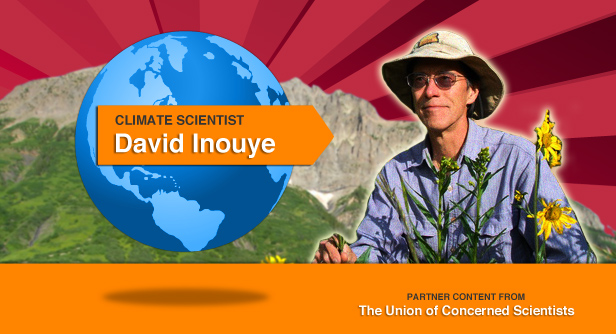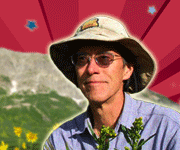Spring certainly seems to arrive earlier these days than it used to. But is it a sure sign of global warming or just natural variability? After decades of careful research on wildflowers, University of Maryland ecologist David Inouye has some definitive — and disturbing — answers. This summer Inouye returns to the Rocky Mountain Biological Laboratory for the 40th consecutive year to study changes in wildflower populations some 9,500 feet high in the Rocky Mountains near Crested Butte, Colo. His work offers some of the most detailed understanding yet about climate change and its effects on alpine plant and animal species.

Each growing season for the past four decades, Inouye and his team have tracked changes every other day on some 30 separate 2-meter-square plots of land. He and his team have recorded the health and welfare of roughly 4 million individual wildflowers-and they correlate that data with variables such as air temperature and snow-melt dates. It turns out that you can learn a lot by looking at the same pieces of land so closely for so long.
First of all, Inouye explains, the technique offers precise data about the area’s “phenology” — scientists’ fancy term for seasonal rhythms such as bloom times and bird migrations. The changes in bloom times are glaring in Inouye’s Rocky Mountain plots. “Just 10 years ago, this project was perfectly timed with the academic calendar,” he explains. In mid-May, as soon as Inouye wound up his teaching duties at the University of Maryland, he would head out to his beloved mountains just in time to track wildflower blooms. But now some of the flowers he studies begin blooming by mid-April. To continue his research, Inouye has had to pay assistants to track flowering that occurs before he is able to arrive on site.
The careful tracking of bloom times over many years provides an important indicator of climate change. But Inouye’s research also shows that bloom times are part of an intricate and often delicate natural dance that is in many cases disrupted by climate change. Inouye is an expert on pollinators like bees and butterflies, and his research has shed light on a growing problem known as “phenological mismatches,” in which plants and pollinators adapt at different rates to a changing climate. As a member of a National Research Council panel on the health of pollinators, Inouye has recommended devoting more resources to closely tracking potential climate threats to creatures like honeybees and native bees, which play such a vital and often underappreciated role in agriculture, from alfalfa fields to fruit orchards.
Inouye says that while several studies in Europe suggest that some species of wildflowers and their pollinators may successfully migrate north and to higher elevations, his research in the Rocky Mountain meadows indicates that many varieties of wildflowers may not be able to migrate as quickly as the climate is changing. In the case of the Aspen sunflower (Helianthella quinquenervis), for instance, global warming has led to smaller snow packs in the mountains, which means earlier snow melts — an important cue for wildflower blooms.
Paradoxically, as the Aspen sunflowers are triggered to bloom earlier each year, it becomes more likely that they will be damaged by exposure to late spring frost. Inouye’s research shows that from 1992 to 1998, such frosts on average killed about a third of the Aspen sunflower buds in his plots. Between 1999 and 2006, however, the typical percentage doubled, with nearly three-quarters of all buds being killed by frost in an average year. Inouye says he has seen whole fields of this particular flower (shown in the photograph) decimated by frost. “Given the rate of global warming, we’ll see some wildflower extinctions,” he says. “There is little doubt about that.”
Adding further to Inouye’s concerns are the results of an experiment by a team of his colleagues at the Rocky Mountain Laboratory. That group, led by John Harte, put electric heaters over meadows in the alpine region not far from Inouye’s plots to simulate the warming temperatures expected in coming years. The research provided clear evidence that the wildflower meadows Inouye studies will probably be entirely displaced by sagebrush desert in just 50 years if current rates of warming continue unchecked.
Inouye grew up in the suburbs of Philadelphia, and he traces his love of nature to the hikes he took as a boy with his grandmother. As a result of her influence, he says, he had sizable collections of bird nests and butterflies by the time he was 9 years old. “I had a pretty normal upbringing in school and playing Little League baseball,” he says. “But I think I knew from an early age that I was fascinated by the natural world around me.”
When Inouye first encountered the Rocky Mountain Biological Laboratory before starting graduate school, he says, he found an amazing community of researchers and an environment he knew he wanted to study for years to come. “Every day I have been out here,” Inouye says, “I think about how beautiful a spot it is. Each day in the summer I wander several miles in the mountains. It helps me to stay closely tuned in to changes underway in a place I know and love.”
This is the sixth installment of America’s Climate Scientists: A series from the Union of Concerned Scientists. Click here to read all the climate scientist profiles.
The Union of Concerned Scientists is currently leading a campaign to elevate the voices of climate scientists and educate the public about the overwhelming scientific evidence for human-caused global warming. Learn how you can get involved at www.ucsusa.org/evidence.



